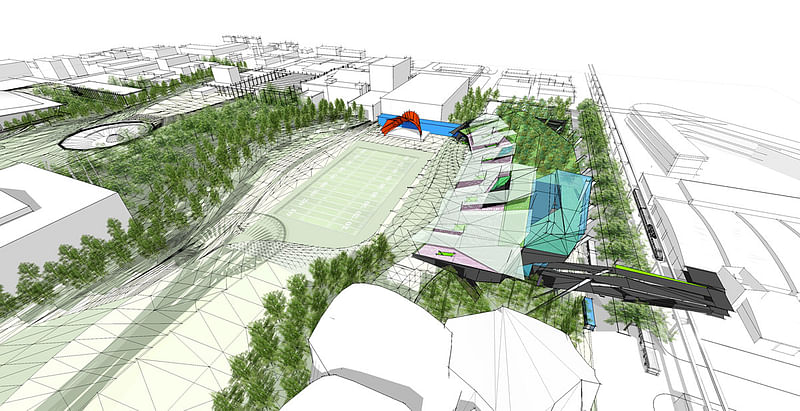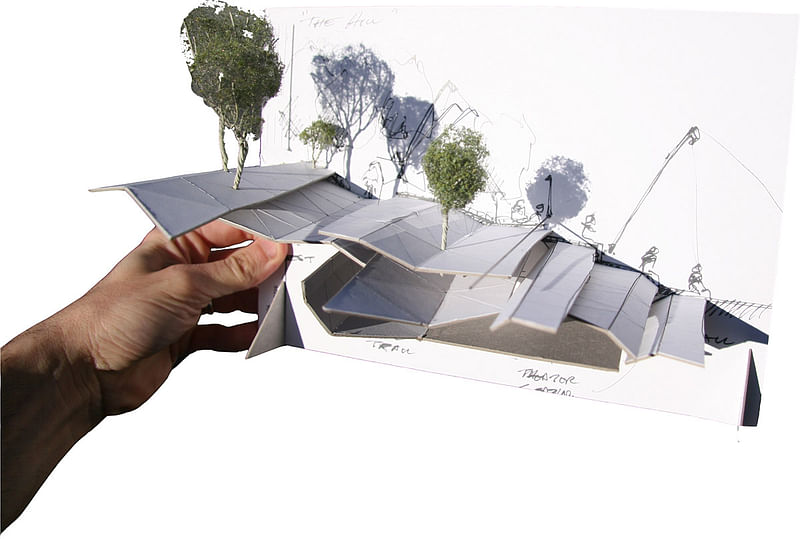Urban Intervention Finalist: Park by Koning Eizenberg Architecture + ARUP
By Bustler Editors|
Monday, Apr 9, 2012

Related
Back in March, three finalist entries were announced at Urban Intervention: The Howard S. Wright Design Ideas Competition for Public Space. The competition challenged architects to re-envision a nine-acre site in central Seattle and use it to explore innovation in public space in the coming century. We had already published PRAUD's "Seattle Jelly Bean" proposal, and here's now also the finalist entry "Park" by Southern Californian practice Koning Eizenberg Architecture in collaboration with ARUP.
All three finalist submissions are currently in the process of design phase two.
Project Description from the Architects:
Overview
Public space is not solely a collection of activities, but an experience. This design proposes a park that organizes the disparate elements of the Seattle Center site and program into a sustainable and coherent setting. It draws on the picturesque landscape tradition casting the groomed playing field as a meadow within a wild rolling landscape featuring regionally indigenous plants. In this contemporary interpretation topography is twisted and landscape is borrowed by a forest-capped hybrid building.
Bike and walking paths weave through the landscape alongside swales that pick up water run-off. To the east along Fifth Avenue North, the Ridge – part stadium, part landscape, part building – houses indoor recreational uses and shelters a multimodal mobility hub devised to strengthen city connections and re-balance local and tourist use. This reinvented natural world celebrates nature and creates an experience with roots in the past and a vision of an ecologically resilient city.

Fountain
A large public plaza anchors the west end of the Park with connections to cultural facilities and the Lower Queen Anne neighborhood and provides a venue for a Farmers Market or other smaller neighborhood based activities.
Forest
A varied topography, planted with native trees and shrubs, integrates bicycle, pedestrian paths and catchment swails. The Forest offers a natural encounter and underpins the educational mission of the adjacent Children’s Museum

Hill
A loose series of terraces overlooking the field provide picnic opportunities and informal grandstands as well as a location for a temporary stage.
Field
Laid out for organized sports, the Field can also sustain informal gatherings and cultural events. A perimeter storm water system collects water for treatment, storage, and re-use. To the north is a lightweight band shell over a permanent stage which acts as a balance to the space needle at the far south end of the field. Behind the band shell, Republican Street is transformed with cafes and concessions to serve the existing theater district, events and the neighborhood at large.

Ridge
This hybrid stadium building has two distinct faces – one oriented to the field and forest band to the west and one to Fifth Avenue North to the east. The building program includes a forest-capped grandstand that expands seating capacity to more than 20,000 (including informal seating on the wooded crest and sloping lawns below) and street-facing public recreation facilities and mobility hub. The indoor public recreation facility faces Fifth Avenue North and the undercroft provides passage between street and park.

Avenue
On Fifth Avenue, the Ridge creates an urban edge and shelters a mobility hub and pedestrian bridges that connect to an expanded monorail line. The mobility hub is a civic place with kiosks and seating areas, bicycle share stations, and electric vehicle charging center for a shared EV car program. Sub-grade robotic parking supplements existing public parking across the street.

Bay to Lake
The Seattle Center sits at the crest of two significant watersheds that collect into Lake Union and the Bay. They are connected by Broad Street and marked at their shorelines by public parks. Being at the top of the watershed offers an opportunity to create a connecting link between these parks and their shoreline ecologies.
From Patchwork to Fabric
The Park design reorients the landscape into north-south strands that reframe the Seattle Center patchwork of existing institutions and features in a unified setting. The strands – Fountain, Forest, Hill, Field, Ridge, and Street – are keyed and described in the section on Board 1.

Connections
- The north-south strands orient paths that connect the Mercer Street Theater District to the arena and cultural institutions to the south.
- The Ridge program (stadium, mobility hub, and recreation center) encourages balanced use year-round by locals and tourists.
- The monorail extension expands public transportation infrastructure.
- The proposed design links Olympic Scuplture and Lake Union shoreline parks to create a new network of public space in the city.
- A low-carbon combined heat and power (CHP) plant will be located at the Ridge, with a biomass-fueled generator to produce heat for seasonal heating demands, electricity for the EV charging stations, and electrical loads in the Ridge and concessions building.
- The EV charging station taps off-peak nightime capacity at the existing electrical substation located at Taylor and Broad.

Team Members / Design Credits:
Koning Eizenberg Architecture (Nathan Bishop, Architecture; Julie Eizenberg, Architecture; Troy Fosler, Architecture; Rachel Bagan, Architecture; Annie Danis, Research and Communications);
ARUP (Roberto Ammendola, Structures, Visualization and Simulation; Bruce Danziger, Structures; Russell Fortmeyer, Sustainability, Energy Infrastructure; Laura Klein, Structures; Trevor Mino, Civil; Elizabeth Valmont, Acoustics);
Nancy Goslee Power and Associates (Nancy Goslee Power, Landscape Architecture Consultant; Joe Sturges, Landscape Architecture Consultant; Dan Sturges, Transportation/Mobility, Wheel Change: Consultant)

Share
0 Comments
Comment as :